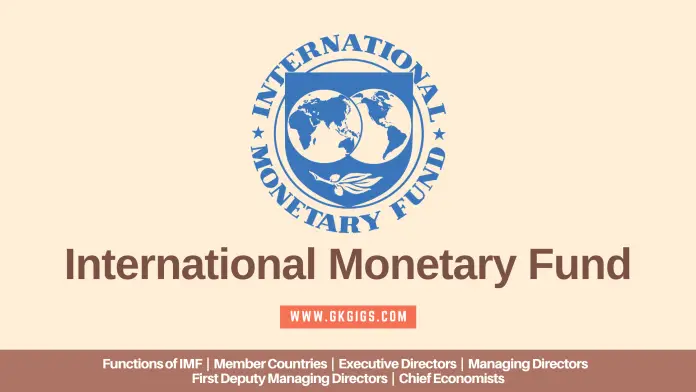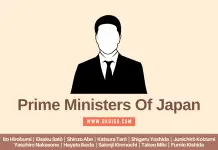
Last Updated: 3 December 2023
Many a time we hear about IMF or International Monetary Fund but do you know what is International Monetary Fund and what its Functions are?
The International Monetary Fund (IMF) is an international financial institution formed in 1944 and headquartered in Washington, D.C., consisting of 190 countries (189 UN Countries and Kosovo).
Though IMF was created in 1944 it was started on 27 December 1945 at the Bretton Woods Conference primarily by the ideas of Harry Dexter White and John Maynard Keynes. IMF came into formal existence in 1945 with 29 member countries and aimed to reconstruct the international monetary system.
The stated mission of the International Monetary Fund (IMF) is “Working to Foster Global Monetary Cooperation, Secure Financial Stability, Facilitate International Trade, Promote High Employment and Sustainable Economic Growth, and Reduce Poverty Around the World.”
It now plays a central role in the management of balance of Payments Difficulties and International Financial Crises. Countries contribute funds to a pool through a quota system from which countries experiencing balance of payments problems can borrow money. As of 2016, the fund had XDR 477 billion (about US$667 billion).
Page Contents
IMF At A Glance
| No. | Header | Information |
|---|---|---|
| 1 | Formation | IMF |
| 2 | Formation | 27th December 1945 |
| 3 | Type | International Financial Institution |
| 4 | Purpose | 1) Promote International Monetary Co-operation 2) Facilitate International Trade 3) Foster Sustainable Economic Growth 4) Make Resources Available to Members Experiencing Balance of Payments Difficulties 5) Prevent and Assist with Recovery from International Financial Crises |
| 5 | Headquarters | Washington, D.C., U.S. |
| 6 | Membership | 190 Countries |
| 7 | Official language | English |
| 8 | Managing Director | Kristalina Georgieva |
| 9 | First Deputy Managing Director | Gita Gopinath |
| 10 | Chief Economist | Pierre-Olivier Gourinchas |
| 11 | Main Organ | United Nations |
| 12 | Budget (2022) | $1.2 billion USD |
| 13 | Staff | 2,400+ |
| 14 | Website | www.imf.org |
Functions of IMF
- It works to foster global growth and economic stability by providing policy advice and financing the members by working with developing countries to help them achieve macroeconomic stability and reduce poverty.
- Upon the founding of the IMF, its three primary functions were to oversee the fixed exchange rate arrangements between countries, thus helping national governments manage their exchange rates and allowing these governments to prioritize economic growth, and providing short-term capital to aid the balance of payments.
- The IMF was also intended to help mend the pieces of the international economy after the Great Depression and World War II as well as to provide capital investments for economic growth and projects such as infrastructure.
- IMF negotiates conditions on lending and loans under their policy of conditionality, which was established in the 1950s.
- The IMF is mandated to oversee the international monetary and financial system and monitor its member countries’ economic and financial policies.
- The IMF provides alternate sources of financing such as the Poverty Reduction and Growth Facility.
IMF Member Countries
- Not all member countries of the IMF are sovereign states, and therefore not all “Member Countries” of the IMF are members of the United Nations.
- Amidst “Member Countries” of the IMF that are not member states of the UN are non-sovereign areas with special jurisdictions that are officially under the sovereignty of full UN member states, such as Aruba, Curaçao, Hong Kong, and Macao, as well as Kosovo.
- All members of the IMF are also International Bank for Reconstruction and Development (IBRD) members and vice versa.
- Former members are Cuba (which left in 1964) and Taiwan, which was ejected from the IMF in 1980 after losing the support of then United States President Jimmy Carter and was replaced by the People’s Republic of China.
- Taiwan Province of China is still listed in the official IMF indices.
- Apart from Cuba, the other UN states that do not belong to the IMF are Liechtenstein, Monaco, and North Korea.
- Former Czechoslovakia was expelled in 1954 for “failing to provide required data” and was readmitted in 1990, after the Velvet Revolution.
- Poland withdrew in 1950 allegedly pressured by the Soviet Union but returned in 1986.
- Andorra became the 190th member on 16th October 2020.
IMF Executive Directors
| (As of February 2019) |
24 Executive Directors make up the executive board. The executive directors represent all 189 member countries in a geographically based roster. Countries with large economies have their own executive director, but most countries are grouped into constituencies representing four or more countries.
| No. | Country | Region | No. of Member(s) Represented | Director | Country with Most Votes |
|---|---|---|---|---|---|
| 1 | Argentina | Southern South America | 6 | Gabriel Lopetegui | Argentina |
| 2 | Australia | Far East | 15 | Nigel Ray | South Korea |
| 3 | Belgium | 1) Benelux 2) Israel 3) Eastern Europe | 15 | Anthony De Lannoy | Netherlands |
| 4 | Brazil | Northern South America | 11 | Alexandre Tombini | Brazil |
| 5 | Canada | 1) North Atlantic 2) Caribbean | 12 | Louise Levonian | Canada |
| 6 | China | China | 1 | Jin Zhongxia | China |
| 7 | Colombia | 1) Spain 2) Central America | 8 | Leonardo Villar | Spain |
| 8 | Egypt | 1) North Africa 2) Middle East | 11 | Hazem Beblawi | United Arab Emirates |
| 9 | France | France | 1 | Herve de Villeroche | France |
| 10 | Germany | Germany | 1 | Steffen Meyer | Germany |
| 11 | India | Indian subcontinent | 4 | Surjit Bhalla | India |
| 12 | Indonesia | Southeast Asia | 13 | Juda Agung | Indonesia |
| 13 | Iran | 1) Iran 2) Middle East | 8 | Jafar Mojarrad | Iran |
| 14 | Italy | Mediterranean Europe | 6 | Domenico G. Fanizza | Italy |
| 15 | Japan | Japan | 1 | Masaaki Kaizuka | Japan |
| 16 | Mauritania | Africa 2 | 23 | Mohamed-Lemine Raghani | Democratic Republic of the Congo |
| 17 | Russia | Russia | 2 | Aleksei V. Mozhin | Russia |
| 18 | Saudi Arabia | Saudi Arabia | 1 | Maher Mouminah | Saudi Arabia |
| 19 | South Africa | Africa 1 | 23 | Dumisani Mahlinza | South Africa |
| 20 | Sweden | Northern Europe | 8 | Thomas Östros | Sweden |
| 21 | Switzerland | 1) Switzerland 2) Poland 3) Near East | 9 | Paul Inderbinen | Switzerland |
| 22 | Turkey | Central Europe | 8 | Raci Kaya | Turkey |
| 23 | United Kingdom | United Kingdom | 1 | Shona E. Riach | United Kingdom |
| 24 | United States | United States | 1 | Mark Rosen | United States |
Related: List Of NATO Countries (2024 Updated)
IMF Managing Directors
The IMF is led by a managing director, who is head of the staff and serves as Chairman of the executive board. The managing director is the most powerful position at the IMF. Historically, the IMF’s managing director has been a European citizen and the president of the World Bank has been an American citizen.
| Term | Director | Term In | Term Out | Citizenship | Background |
|---|---|---|---|---|---|
| 1st | Camille Gutt | 6 May 1946 | 5 May 1951 | Belgium | 1) Politician 2) Economist 3) Lawyer 4) Economics Minister 5) Finance Minister |
| 2nd | Ivar Rooth | 3 Aug 1951 | 3 Oct 1956 | Sweden | 1) Economist 2) Lawyer 3) Central Banker |
| 3rd | Per Jacobsson | 21 Nov 1956 | 5 May 1963 | Sweden | 1) BIS 2) Economist 3) Lawyer 4) Academic 5) League of Nations |
| 4th | Pierre-Paul Schweitzer | 1 Sep 1963 | 31 Aug 1973 | France | 1) Lawyer 2) Businessman 3) Civil Servant 4) Central Banker |
| 5th | Johan Witteveen | 1 Sep 1973 | 18 Jun 1978 | Netherlands | 1) CPB 2) Politician 3) Economist 4) Academic 5) Finance Minister 6) Deputy Prime Minister |
| 6th | Jacques de Larosière | 18 Jun 1978 | 15 Jan 1987 | France | 1) Businessman 2) Civil Servant 3) Central Banker |
| 7th | Michel Camdessus | 16 Jan 1987 | 14 Feb 2000 | France | 1) Economist 2) Civil Servant 3) Central Banker |
| 8th | Horst Köhler | 1 May 2000 | 4 Mar 2004 | Germany | 1) Politician 2) Economist 3) Civil Servant 4) EBRD 5) President |
| 9th | Rodrigo Rato | 7 Jun 2004 | 31 Oct 2007 | Spain | 1) Politician 2) Businessman 3) Economics Minister 4) Finance Minister 5) Deputy Prime Minister |
| 10th | Dominique Strauss-Kahn | 1 Nov 2007 | 18 May 2011 | France | 1) Politician 2) Economist 3) Lawyer 4) Businessman 5) Economics Minister 6) Finance Minister |
| 11th | Christine Lagarde | 5 Jul 2011 | 12 Sep 2019 | France | 1) Politician 2) Lawyer 3) Finance Minister |
| 12th | Kristalina Georgieva | 1 Oct 2019 | ~ | Bulgaria | 1) Politician 2) Economist |
IMF First Deputy Managing Directors
The Managing Director (MD) is assisted by a First Deputy Managing Director (FDMD) who, by convention, has always been a citizen of the United States. Together, the Managing Director and his/her First Deputy lead the Senior Management of the IMF.
| Term | Name | Term In | Term Out | Citizenship | Background |
|---|---|---|---|---|---|
| 1st | Andrew Overby | 9 Feb 1949 | 24 Jan 1952 | U.S. | 1) Banker 2) Senior U.S. Treasury Official |
| 2nd | Merle Cochran | 16 Mar 1953 | 31 Oct 1962 | U.S. | U.S. Foreign Service Officer |
| 3rd | Frank Southard | 1 Nov 1962 | 28 Feb 1974 | U.S. | 1) Economist 2) Civil Servant |
| 4th | William Dale | 1 Mar 1974 | 31 May 1984 | U.S. | Civil Servant |
| 5th | Richard Erb | 1 Jun 1984 | 31 Aug 1994 | U.S. | 1) Economist 2) White House Official |
| 6th | Stanley Fischer | 1 Sep 1994 | 31 Aug 2001 | Israel + U.S. | 1) Economist 2) Banker 3) Central Banker |
| 7th | Anne Kreuger | 1 Sep 2001 | 31 Aug 2006 | U.S. | Economist |
| 8th | John Lipsky | 17 Jul 2006 | 11 Nov 2011 | U.S. | Economist |
| 9th | David Lipton | 1 Sep 2011 | 28 Feb 2020 | U.S. | 1) Economist 2) Senior U.S. Treasury Official |
| 10th | Geoffrey Okamoto | 20 Mar 2020 | 20 Jan 2022 | U.S. | 1) Bank Consultant 2) Senior U.S. Treasury Official |
| 11th | Gita Gopinath | 21 Jan 2022 | ~ | U.S. | 1) Chief Economist of IMF 2) Professor at Harvard University’s Economics Department |
IMF Chief Economists
The Chief Economist of the International Monetary Fund is also the economic counselor and director of the fund’s Research Department and is responsible for providing independent advice to the fund on its policy issues, integrating ideas of the research in the design of policies, conveying these ideas to the policymakers inside and outside the fund and managing all research done at IMF.
| Term | Chief Economists | Term In | Term Out | Citizenship |
|---|---|---|---|---|
| 1st | Edward Bernstein | 1946 | 1958 | United States |
| 2nd | Jacques Polak | 1958 | 1980 | Netherlands |
| 3rd | William Hood | 1980 | 1987 | Canada |
| 4th | Jacob Frenkel | 1987 | 1991 | Israel |
| 5th | Michael Mussa | Aug 1991 | 29 Jun 2001 | United States |
| 6th | Kenneth Rogoff | Aug 2001 | Sep 2003 | United States |
| 7th | Raghuram Rajan | Sep 2003 | Jan 2007 | India |
| 8th | Simon Johnson | Mar 2007 | 31 Aug 2008 | United Kingdom United States |
| 9th | Olivier Blanchard | 1 Sep 2008 | 8 Sep 2015 | France |
| 10th | Maurice Obstfeld | 8 Sep 2015 | 31 Dec 2018 | United States |
| 11th | Gita Gopinath | 1 Jan 2019 | 21 Jan 2022 | United States |
| 12th | Pierre-Olivier Gourinchas | 24 Jan 2022 | ~ | France |
Voting Power of IMF Members
Voting power in the International Monetary Fund is based on a quota system. Each member has a number of basic votes plus one additional vote for each Special Drawing Right (SDR) of 100,000 of a member country’s quota. Changes in the voting shares require approval by a super-majority of 85% of the voting power.
| Rank | Country | Governor | Alternative | % of Votes |
|---|---|---|---|---|
| 1 | United States | Andy Baukol | Vacant | 16.50 |
| 2 | Japan | Shunichi Suzuki | Haruhiko Kuroda | 6.14 |
| 3 | China | Gang Yi | Yulu Chen | 6.08 |
| 4 | Germany | Joachim Nagel | Christian Lindner | 5.31 |
| 5 | France | Bruno Le Maire | François Villeroy de Galhau | 4.03 |
| 6 | United Kingdom | Rishi Sunak MP | Andrew Bailey | 4.03 |
| 7 | Italy | Daniele Franco | Ignazio Visco | 3.02 |
| 8 | India | Nirmala Sitharaman | Shaktikanta Das | 2.63 |
| 9 | Russia | Anton Siluanov | Elvira S. Nabiullina | 2.59 |
| 10 | Brazil | Paulo Guedes | Roberto Campos Neto | 2.22 |
| 11 | Canada | Chrystia Freeland | Tiff Macklem | 2.22 |
| 12 | Saudi Arabia | Mohammed Al-Jadaan | Fahad A. Almubarak | 2.01 |
| 13 | Spain | Nadia Calviño | Pablo Hernández de Cos | 1.92 |
| 14 | Mexico | Rogelio Eduardo Ramirez de la O | Victoria Rodríguez Ceja | 1.80 |
| 15 | Netherlands | Klaas Knot | Christiaan Rebergen | 1.76 |
| 16 | South Korea | Choo Kyung-ho | Rhee Chang-yong | 1.73 |
| 17 | Australia | Josh Frydenberg, M.P. | Steven Kennedy | 1.33 |
| 18 | Belgium | Pierre Wunsch | Vincent Van Peteghem | 1.30 |
| 19 | Switzerland | Thomas Jordan | Ueli Maurer | 1.17 |
| 20 | Turkey | Nureddin Nebati | Şahap Kavcıoğlu | 0.95 |
| 21 | Indonesia | Perry Warjiyo | Sri Mulyani Indrawati | 0.95 |
| 22 | Sweden | Stefan Ingves | Elin Eliasson | 0.91 |
| 23 | Poland | Mateusz Morawiecki | Marta Kightley | 0.84 |
| 24 | Austria | Robert Holzmann | Gottfried Haber | 0.81 |
| 25 | Singapore | Tharman Shanmugaratnam | Ravi Menon | 0.80 |
Related: List Of International Organizations & Top Institutions Headquarters
Full Forms Related To IMF
| No. | Acronyms | Full Form |
|---|---|---|
| 1 | CCRT | Catastrophe Containment and Relief Trust |
| 2 | CRA | Contingent Reserve Arrangement |
| 3 | ECF | Extended Credit Facility |
| 4 | EBRD | European Bank for Reconstruction and Development |
| 5 | EFF | Extended Fund Facility |
| 6 | FAO | Food and Agriculture Organization |
| 7 | FCL | Flexible Credit Line |
| 8 | FDMD | First Deputy Managing Director |
| 9 | GDDS | General Data Dissemination System |
| 10 | GDP | Gross Domestic Product |
| 11 | IBRD | International Bank for Reconstruction and Development |
| 12 | IMF | International Monetary Fund |
| 13 | IMFC | International Monetary and Financial Committee |
| 14 | LDCs | Less Developed Countries |
| 15 | MD | Managing Director |
| 16 | MDG | Millennium Development Goals |
| 17 | ODI | Overseas Development Institute |
| 18 | OECD | Organization for Economic Co-operation and Development |
| 19 | PLL | Precautionary and Liquidity Line |
| 20 | PRSPs | Poverty Reduction Strategic Papers |
| 21 | RBI | Reserve Bank of India |
| 22 | RCF | Rapid Credit Facility |
| 23 | RFI | Rapid Financing Instrument |
| 24 | SBA | Stand-By Arrangements |
| 25 | SCF | Standby Credit Facility |
| 26 | SDDS | Special Data Dissemination Standard |
| 27 | SDRs | Special Drawing Rights |
| 28 | UNDP | United Nations Development Program |
| 29 | UNICEF | United Nations International Children’s Emergency Fund |
| 30 | WTO | World Trade Organization |
| Read More |
- India And World’s Latest Current Affairs
- General Knowledge Of Europe (Multiple Choice Questions)
- List Of Top 20 Richest Person In The World (2024 Updated)
- 100+ Electric Car Companies With Car Models (2024 Updated)
- Presidents Of The United States Of America In Chronological Order













